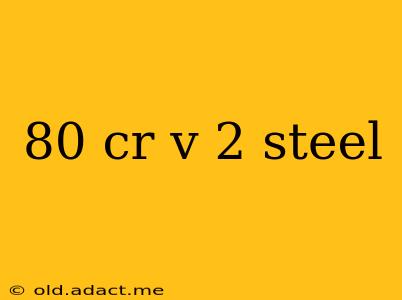80CrV2 steel, also known as 80CrV2 tool steel, is a high-carbon, chromium, and vanadium alloy steel renowned for its exceptional properties. Its balanced blend of hardness, toughness, and wear resistance makes it a popular choice for a wide range of applications, particularly in the tooling and manufacturing industries. This comprehensive guide delves into the specifics of 80CrV2 steel, exploring its composition, characteristics, heat treatment processes, and common uses.
What is 80CrV2 Steel?
80CrV2 steel is a medium-carbon, chromium-vanadium alloy tool steel. The "80" in its designation generally refers to its approximate carbon content of 0.8% (though the exact composition can vary slightly depending on the manufacturer). The chromium and vanadium additions significantly enhance its hardenability, wear resistance, and toughness. These properties make it suitable for applications requiring high durability and resistance to deformation under stress.
Chemical Composition of 80CrV2 Steel
The typical chemical composition of 80CrV2 steel includes:
- Carbon (C): Approximately 0.8% - This contributes significantly to its hardness and strength.
- Chromium (Cr): Typically 1.0% - Improves hardenability, corrosion resistance, and wear resistance.
- Vanadium (V): Usually around 0.2% - Enhances the steel's toughness and refines its grain structure, leading to improved impact resistance and wear resistance.
- Manganese (Mn): Generally present in small amounts to improve strength and machinability.
- Silicon (Si): Also present in small amounts to deoxidize the steel and improve its strength.
Properties of 80CrV2 Steel
The key properties that make 80CrV2 steel so desirable are:
- High Hardness: Achievable through appropriate heat treatment, resulting in excellent wear resistance.
- Good Toughness: Maintains its strength even under impact loads, preventing brittle fracture.
- Excellent Wear Resistance: Resists abrasion and erosion, extending its lifespan in demanding applications.
- High Strength: Possesses superior tensile strength compared to many other tool steels.
- Good Hardenability: Can be hardened to a deep depth, crucial for large tools and components.
Heat Treatment of 80CrV2 Steel
Proper heat treatment is essential to achieve the optimal properties of 80CrV2 steel. The process typically involves:
- Annealing: A softening process that improves machinability before hardening.
- Hardening: Heating the steel to a critical temperature (austenitizing) followed by rapid quenching (usually in oil or air) to achieve maximum hardness.
- Tempering: A subsequent heating to a lower temperature that relieves internal stresses and reduces brittleness, adjusting the final hardness and toughness balance.
The specific heat treatment parameters (temperatures and times) will vary depending on the desired final properties and the size and shape of the component. This is often determined through trial and error or using metallurgical testing.
What is the best heat treatment for 80CrV2 steel?
The "best" heat treatment for 80CrV2 steel is highly dependent on the intended application. There's no single answer. A tool requiring maximum wear resistance might need a different tempering temperature than one prioritizing toughness. Consulting a metallurgical expert or utilizing established heat treatment charts for 80CrV2 steel is recommended.
Applications of 80CrV2 Steel
The versatile nature of 80CrV2 steel makes it suitable for a variety of applications, including:
- Moulds and Dies: Used in injection moulding, forging, and other forming processes where wear resistance and toughness are crucial.
- Cutting Tools: Suitable for punches, chisels, and other tools requiring high hardness and impact resistance.
- Gears and Shafts: Employed in high-stress applications where strength and durability are paramount.
- Automotive Components: Found in various parts demanding high wear and fatigue resistance.
- Hand Tools: Used in tools requiring high strength and durability.
What are the common uses of 80CrV2?
80CrV2 finds its most common applications in tooling, particularly where wear resistance and impact toughness are critical. This includes dies, punches, and various hand tools. Its strength also makes it suitable for components within machinery and automotive parts.
Conclusion
80CrV2 steel is a high-performance alloy steel offering an excellent balance of properties. Its widespread use in tooling and other demanding applications highlights its strength, toughness, and exceptional wear resistance. Understanding its composition, properties, and the critical role of heat treatment is crucial for anyone working with or specifying this valuable material. Always consult with material specialists for precise specifications and heat treatment guidelines tailored to your specific application.
